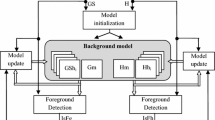Abstract
Current trends in microprocessor design integrate several autonomous processing cores onto the same die. These multicore architectures are particularly well-suited for computer vision applications, where it is typical to perform the same set of operations repeatedly over large datasets. These memory- and computation-intensive applications can reap tremendous performance and accuracy benefits from concurrent execution on multi-core processors. However, cost-sensitive embedded platforms place real-time performance and efficiency demands on techniques to accomplish this task. Furthermore, parallelization and partitioning techniques that allow the application to fully leverage the processing capabilities of each computing core are required for multi-core embedded vision systems. In this paper, we evaluate background modeling techniques on a multicore embedded platform, since this process dominates the execution and storage costs of common video analysis workloads. We introduce a new adaptive backgrounding technique, multimodal mean, which balances accuracy, performance, and efficiency to meet embedded system requirements. Our evaluation compares several pixel-level background modeling techniques in terms of their computation and storage requirements, and functional accuracy for three representative video sequences, across a range of processing and parallelization configurations. We show that the multimodal mean algorithm delivers comparable accuracy of the best alternative (Mixture of Gaussians) with a 3.4× improvement in execution time and a 50% reduction in required storage for optimal block processing on each core. In our analysis of several processing and parallelization configurations, we show how this algorithm can be optimized for embedded multicore performance, resulting in a 25% performance improvement over the baseline processing method.





Similar content being viewed by others
References
Bower, F. A., Sorin, D. J., & Cox, L. P. (2008). The impact of dynamically heterogeneous multicore processors on thread scheduling. IEEE Micro Magazine, 28(3), 17–25. May/Jun.
Gschwind, M. (2007). The cell broadband engine: Exploiting multiple levels of parallelism in a chip multiprocessor. International Journal of Parallel Programming, 35(3), 233–262. June.
Kongetira, P., Aingaran, K., & Olukotun, K. (2005). Niagara: A 32-way multithreaded Sparc processor. IEEE Micro Magazine, 25(2), 21–29. March–April.
McNairy, C., & Bhatia, R. (2005). Montecito: A dual-core, dual-thread Itanium processor. IEEE Micro, 25(2), 10–20. March–April.
Taylor, M. B., et al. (2002). The raw microprocessor: A computational fabric for software circuits and general purpose programs. IEEE Micro Magazine, 22(2), 25–35. March–April.
Sankaralingam, K., et al. “Exploiting ILP, TLP, and DLP with the polymorphous TRIPS architecture,” in Proc. 30 th Annual Int. Symp. On Computer Architecture, pp. 422–433, June 2003.
Chen, T. P., Haussecker, H., Bovyrin, A., Belenov, R., Rodyushkin, K., Kuranov, A., Eruhimov, V., “Computer Vision Workload Analysis: Case Study of Video Surveillance Systems”, Intel Tecnology Journal 2005.
Cheung, S., & Kamath, C. (2004). Robust techniques for background subtraction in urban traffic video. Video Communications and Image Processing, 5308, 881–892. SPIE Electronic Imaging, San Jose, January.
Piccardi, M. (2004). Background subtraction techniques: A review. IEEE International Conference on Systems, Man and Cybernetics, 4, 3099–3104. October.
Toyama, K., Krumm, J., Brummitt, B., Meyers, B. (). Wallflower: principles and practices of background maintenance,” in Proc. of ICCV (1), pp. 255–261, 1999; Wallflower benchmarks available online at research.microsoft.com/~jckrumm/WallFlower/TestImages.htm
McFarlane, N., & Schofield, C. (1995). Segmentation and tracking of piglets in images. Machine Vision and Applications, 8(3), 187–193.
Jabri, S., Duric, Z., Wechsler, H., & Rosenfeld, A. (2000). Detection and location of people in video images using adaptive fusion of color and edge information. IEEE International Conference on Pattern Recognition, 4, 627–630 September.
Wren, C. R., Azarbayejani, A., Darell, T., & Pentland, A. P. (1997). Pfinder:real-time tracking of human body. IEEE Transactions on Pattern Analysis and Machine Intelligence, 19(7), 780–785. July.
Stauffer, C. & Grimson, W. E. L. (1999). Adaptive background mixture models for real-time tracking”, Computer Vision and Pattern Recognition, pp 246–252, June.
Stauffer, C., & Grimson, W. E. L. (2000). Learning patterns of activity using real-time tracking. IEEE Transactions on Pattern Analysis and Machine Intelligence, 22(8), 747–757. August.
Appiah, K., Hunter, A. (2005). A single-chip FPGA implementation of real-time adaptive background model. IEEE International Conference on Field-Programmable Technology, pp. 95–102, December.
Chen, T., Budnikov, D., Hughes, C., Chen, Y.-K. (2007). Computer vision workloads on multicore processors: articulated body tracking”, ICME 2007, Beijing, China, July.
Zinner, C. & Kubinger, W. (2006). “ROS-DMA: A DMA double buffering method for embedded image processing with resource optimized slicing,” in Proc. 12 th IEEE Real-Time and Embedded Technology and Applications Symposium (RTAS), pp. 361–372, April.
T.G. Lane. Using the IJG JPEG Library. Independent JPEG Group, 6b edition, March 1998.
Cell Broadband Engine Programming Tutorial http://www-01.ibm.com/chips/techlib/techlib.nsf
S. Apewokin, B. Valentine, S. Wills, L. Wills, A. Gentile, “Multimodal Mean Adaptive Backgrounding for Embedded Real-Time Video Surveillance,” Embedded Computer Vision Workshop (ECVW07),, June 2007.
Acknowledgements
We are grateful for the insightful comments of the anonymous reviewers.
Author information
Authors and Affiliations
Corresponding author
Rights and permissions
About this article
Cite this article
Apewokin, S., Valentine, B., Choi, J. et al. Real-Time Adaptive Background Modeling for Multicore Embedded Systems. J Sign Process Syst 62, 65–76 (2011). https://doi.org/10.1007/s11265-008-0298-z
Received:
Revised:
Accepted:
Published:
Issue Date:
DOI: https://doi.org/10.1007/s11265-008-0298-z




